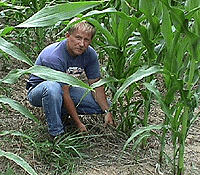Production of New Livestock Feed Crops Featured At Robinson Station All Commodities Field Day
Production of New Livestock Feed Crops Featured At Robinson Station All Commodities Field Day

Robinson Station has many agricultural research projects under way, including two on potential new livestock feed crops. These projects are among the research tours taking place July 22 during the All Commodities Field Day at the University of Kentucky College of Agriculture's Robinson Station near Quicksand.
Kura clover, which resembles red clover, is a true perennial with potential as a new high-quality livestock feed. However, the time required to establish a stand suitable for hay or pasture has kept many Kentucky livestock producers from using kura clover because they can't wait two years for a stand to become established, according to David Ditsch, Extension agronomist at Robinson Station.
"When you seed kura clover," he explained, "it germinates and emerges quickly making it appear that you're off to a good start. But the first year, plants devote more energy to establishing a root system than producing vegetative growth so it takes longer to establish a productive stand. To solve this problem, we're collecting kura clover rhizomes from an established stand and evaluating tillage methods for putting these ‘sprigs' in contact with the soil to produce a stand of larger plants more quickly.
"Once kura clover becomes established, you have a high-quality livestock forage from a nutritive point of view. Plus it's productive year after year, compared to two to three years of productivity for red clover."
Although scientists hope this research will lead to a good way to establish kura clover quickly, they're not putting all their eggs in the proverbial one basket, according to Ditsch.
"Since establishing kura clover by seeding would be more efficient and economical, Norman Taylor, who specializes in breeding legumes, is working to develop varieties that will establish more quickly when seeded," he explained.
In another research project on new feed crops for livestock, Morris Bitzer is looking into using baled kenaf silage as an emergency livestock feed for producers hit hard by summer droughts.
"We're looking at the yield potential and quality of ensiled kenaf as livestock forage," said Bitzer, an Extension agronomist based in Lexington. "We cut the crop at an early stage to produce livestock feed that's palatable and easily digestible; then round baled it and put it in a solid plastic wrap to make silage. A quality analysis of this kenaf silage will be available at the field day. When cut at the right maturity, kenaf can almost equal the quality of alfalfa.
"This project is some of the first research done on round baling kenaf silage. In fact, we believe this is the first kenaf silage bale ever made." In addition to the field day tours on new crops for livestock, visitors also will see no-till tobacco research on fertility and weed control. Another tobacco tour will be on field curing structures.
"We're fertilizing tobacco plants with the same system we use to irrigate them," Ditsch said. "With this fertigation system, we can apply lower doses of nitrogen throughout the growing season. These smaller doses match the plants' nutritional needs and reduce the amount of unused nitrogen remaining in the soil."
Another field day tour is on weed control in no-till tobacco.
"Kentucky ranks among the highest in the nation for adoption of no-till grain production," explained Robert Pearce, Extension agronomist in Lexington. "Recent advances in weed control have made no-till burley tobacco production more feasible. At Robinson Station, we're investigating the effects of burn-down timing on weed control and the growth of no-till tobacco. We'll discuss the results of this test on the early growth of tobacco at the field day."
No-till tobacco trials are being conducted in 17 Kentucky counties this year, he added.
On another tobacco tour, visitors will see two configurations of the same field-curing structure to illustrate the differences in handling and labor required to fill each structure. One structure is designed for a wagon to pull beneath it and the other has a wagon pull beside it, said to Brian Jeffers, Extension agent for agriculture and natural resources in Johnson County.
Field day visitors also will see variety trials of several forages being considered for livestock feed, and trials on sorghum varieties, including some being evaluated for disease tolerance and resistance. Other tours will be on no-till corn response to sulfur fertilization, cultural methods (timing of mowing and chemical treatment) to control ironweed in pastures and hay fields, and round bale silage of fescue, orchard grass and alfalfa for livestock feed.
Sources: Morris Bitzer (606) 257-3975
David Ditsch (606) 666-2438, Ext. 231
Robert Pearce (606) 257-5110
Brian Jeffiers (606) 789-8108
